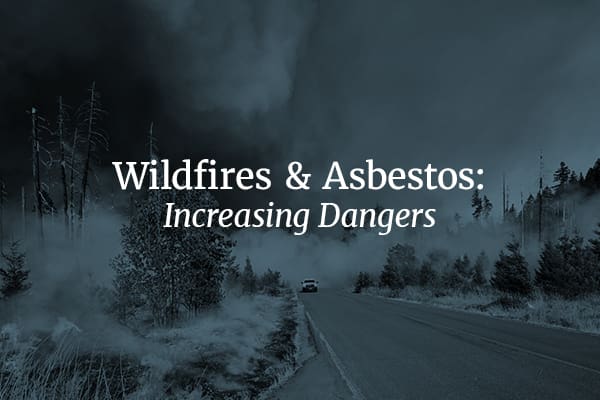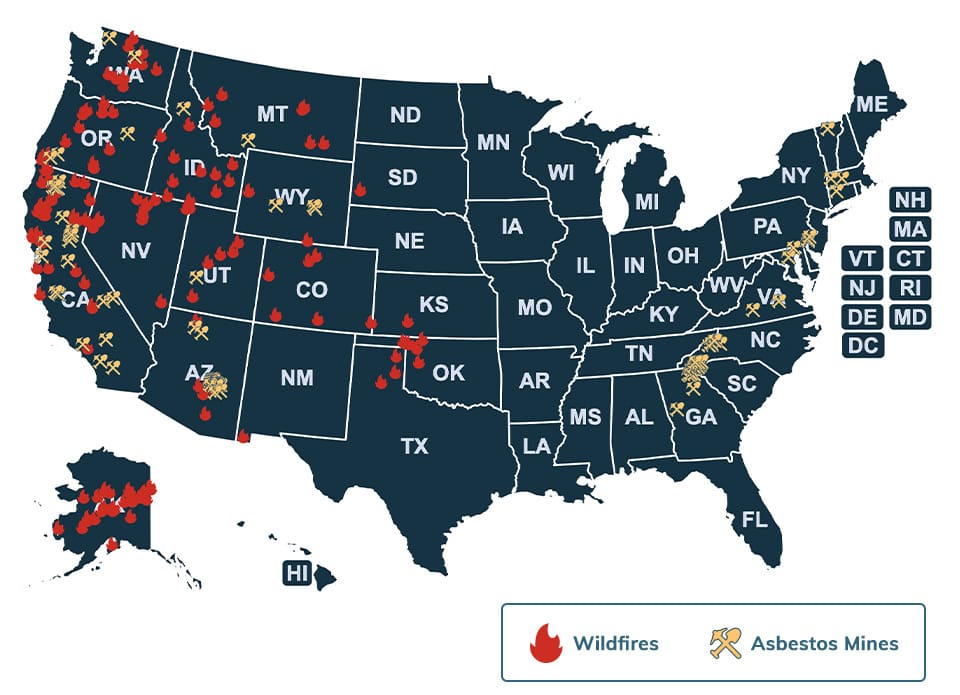
On the morning of January 7, 2025, Pacific Palisades residents noticed smoke cresting a nearby hill. It came from a 10-acre fire that would grow to roughly 200 acres in less than half an hour. A second fire, dubbed the Eaton fire, started hours later.
Fueled by wind gusts of over 80 miles per hour, fire officials reported that in 3 weeks the wildfires caused 29 deaths and destroyed 16,255 structures. The fires had burned more than 37,000 acres.
Environmental experts are warning residents to take precautions before returning to their homes. Burned buildings may have many toxic substances in the debris, including asbestos. Companies used asbestos in common building materials to make homes and other buildings constructed before the 1980s.
Information about the age of the destroyed buildings is not yet available. But some historic buildings were lost in the fire:
- The Altadena Community Church, built in the 1940s
- The Benedict and Nancy Freedman House, designed in the 1950s
- The historic Pacific Palisades Business Block, built in 1924
- The prefabricated Park Planned Homes, built in the 1940s
Some of these buildings and others erected before the 1980s may still have contained asbestos. People exposed to asbestos because of these fires may now be at risk of developing mesothelioma in the future.
Increase in Wildfires Puts More People at Risk of Asbestos Exposure
As wildfires become more frequent, more communities face a greater risk of asbestos exposure. Any level of asbestos exposure can be dangerous if the mineral is inhaled or ingested. It can lead to asbestos-related diseases, like mesothelioma and other asbestos cancers.
Buildings constructed before the 1980s often had asbestos. In 1988, the Environmental Protection Agency (EPA) estimated that 20% of buildings in the United States contained asbestos. Undisturbed, asbestos building materials may not pose an exposure risk, but fires can release the mineral into the atmosphere.
The National Interagency Fire Center (NIFC) started tracking wildfire data in 1983. Their statistics show the 10 most destructive fires have all occurred in the past 20 years, an indication of how dangerous the situation has become.
Wildfires have caused significant damage to people’s property and racked up massive costs to fight them. The NIFC data shows the cost to fight fires between 2003 and 2012 averaged $1,307,081,300. Between 2013 and 2022, the average hit $2,523,259,200.
According to data for 2005 – 2023, wildfires burned more than 103,900 homes, businesses and other structures. Many of these homes likely contained asbestos products that released fibers into the air, which people in the community may have inhaled.
Beyond the cost to fight the fires (suppression costs), the total cost spent after a fire includes rehabilitation and other indirect costs. The NIFC reports more than $3.1 billion in suppression costs during the 2023 fire season. A 2023 report from the Joint Economic Committee notes the average total cost of wildfires is between $394 and $893 billion annually. These figures include lower real estate values, insurance payouts, lost income and more.
The number of fires and their severity fluctuates from year to year. However, overall data shows a growing problem. Larger and more destructive fires are becoming more frequent.
In one study, researchers analyzed data from 1984 to 2018. They found that the Western and Eastern regions of the U.S. saw twice as many fires after 2005 as before 1999. The Great Plains had four times as many fires.
Three facts weigh heavily on the situation. First, since the 1970s, the wildfire season has lengthened from five to seven months. Second, there was a decades-long widespread use of asbestos in buildings. Third, natural asbestos deposits and mines create another potential hazard.
Environmental Asbestos Creates More Hazards
Asbestos mines and natural deposits can also pose risks during wildfires. During the mining process, asbestos present in the deposit may contaminate other minerals and the area around the mine. Wildfires can spread asbestos from natural deposits and mining operations.
Libby, Montana, is an example. Vermiculite was mined from the area mines. That vermiculite was near an asbestos deposit, leading to the asbestos contaminating the acreage surrounding the mine. This makes any fires in the area potential sources of asbestos exposure.
The United States has 876 naturally occurring asbestos deposits. Of those, 142 were once active mines. A long, uncontrolled burn near one of these mines increases asbestos exposure risks. That risk extends beyond the immediate area.
While asbestos resists heat well, burning asbestos-containing materials make them brittle or friable (crumbly). Asbestos becomes very dangerous when materials become friable. Regardless, many companies used asbestos because of its durability and resistance to heat and fire. Research shows that an average of 92% of the asbestos stays behind in the ash, but the rest could become airborne. Those researchers also note asbestos fibers can remain airborne for hours or days.
Sometimes, the smoke and ash from a wildfire can travel hundreds or thousands of miles away. If those particles contain asbestos, people far from the site can be affected. Airborne asbestos can also settle and become airborne again with a gust of wind.
Tips to Protect Yourself From Asbestos Exposure During Wildfires
Precaution and preparation are critical in the face of increased fire risks. Wildfires and burning structures caused by them can release many toxins. This danger has led emergency officials to take steps to protect the public.
If you live in an area where wildfires have become more common, you can take steps to protect yourself and your family from asbestos exposure.
Preparing for Wildfire Season
You can take specific actions before wildfire season starts to help you prepare for it. Remember, more areas are becoming prone to wildfires.
Use these tips to prepare:
- Have your home inspected. If you live in an area prone to wildfires, consider having an asbestos professional inspect your home. If your home does have asbestos, consider hiring an abatement professional to remove it.
- Get a device to receive emergency info. Make sure you have ways to receive emergency messages. A cell phone is always a good idea, but in a large-scale disaster, cellular signals can be disrupted. Use a battery-powered radio as a backup to get additional directions after you evacuate.
- Make an evacuation plan. Sometimes, seconds matter when it comes to getting out of the way of a wildfire. Make sure you and your family know where to go and how to get there. If you have pets, make sure you have a plan for how to get them out safely, too.
- Prepare emergency supplies. You should have three days of supplies you can carry with you. Experts recommend having one month of any medicines you might need. Keep a hard copy of your personal and financial records ready to go. If you’re undergoing medical treatment, have a copy of your medical records, too.
Tips for During a Wildfire
Wildfires can flare up quickly and spread fast. Wildfires spread at an average speed of 14.27 miles per hour. You need to act fast.
If you receive an evacuation order:
- Remain calm. Panicking can slow you down and open you up to mistakes.
- Know your surroundings. Keep an eye on the weather. A change in the wind can mean the fire will change directions. Make sure you know a few routes to get out of the area.
- Be ready to evacuate. Fast. Remember, time matters. You may not have time to gather your belongings before you must evacuate. Take your emergency kit and leave.
- Follow directions. Emergency personnel have training and plans to help evacuate an area quickly. Listen to their directions and follow them.
If you cannot evacuate safely:
- Move furniture away from windows. If the fire approaches your house, things next to windows can heat up and catch fire. Keeping furniture away can help.
- Remove curtains. Curtains, like furniture, can burn when they become too hot. Take them down to prevent this from happening.
- Fill sinks and bathtubs. In an extended emergency, you can drink this water.
- Close all doors. If the house starts to burn, this can help slow the spread. Make sure to close all your doors, but do not lock them in case you need to leave the room quickly.
- Gather your family. You and your family members should gather together so that each of you knows where the others are at all times. Stay away from outside walls.
Navigating Wildfire Aftermath
It may be several days or weeks before you can get back to your home after an evacuation. Officials may delay your return to keep you and your family safe. Practicing precautions after a fire can keep you healthy in the long run.
Follow these tips:
- Only go into a burn area when told it’s safe. A fire can release many different toxic materials, including asbestos. If you go into a burn area before being told it’s safe, you may come into contact with these materials. Emergency services will test to make sure the air and ground are safe.
- Be careful when cleaning up. Even after a burn area is cleared by emergency services, proceed with caution. A burnt building can hold a lot of toxins, including asbestos. Keep this in mind if you choose to recover personal items from the fire. Remember, experts may consider asbestos safe when it’s undisturbed or encapsulated. Once the asbestos-containing materials burn, the asbestos may be very dangerous. Qualified asbestos professionals should clear any contaminated debris.
Raising Awareness and Advocacy
In August 2023, a fire started in a field outside of Lahaina, Hawaii. Within 20 minutes, the fire had jumped a four-lane road and started burning nearby homes. Residents fled, with some jumping into the ocean to save themselves.
By the time the Lahaina fire was out, 97 people had died, and more than 2,000 structures had burned. Cleanup from the fire took considerable time. Nearly a year after the fire, crews had removed more than 319,000 tons of debris, including more than 34 tons of asbestos.
Wildfires pose many risks, and building fires have their own unique risks. You need to understand those risks and how to keep yourself safe before, during and after a fire.
Wildfire intensity and frequency will put more buildings at risk. Asbestos mines will also remain a problem. These two facts together mean fires will cause asbestos dangers until remediation and containment take place. Advocacy groups continue to fight against these dangers by raising awareness of the risks of asbestos exposure and pushing for a national asbestos ban.





